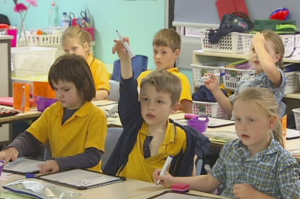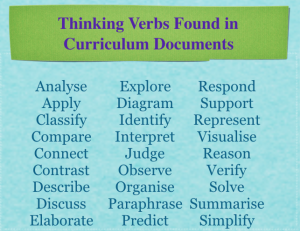Enhancing Thought-Full Classroom Dialogue
Creating an environment within your classroom where every student actively participates in their education is a major goal, and key challenge for educators. An effective way to promoting active participation is through classroom dialogue. Unfortunately many of our students have been educated out of actively being engaged in their education with the fear of making mistakes, years of passive learning and extreme reluctance to enter into dialogue.
Here are 6 ideas and practical ways you can use to enhance thought-full classroom dialogue:
1. Pay attention to your classroom environment.
Encouraging students to speak and share requires a look at the emotional condition of your classroom. Speaking out in front of your peers (at any age!) is a high risk activity. You might be wrong, and ridiculed or worse, might be right – “teacher’s pet – you always know the answer!” The fear of failure and fear of success is real in the classroom. If you are not  sure, go into a new entrant class. Those children want to learn so much. The teacher only has to say; “Who wants”, “Who knows” and most hands go up, before they know what they are being asked. Go further up the school and into a Secondary classroom and most teachers are struggling to have students answer a question – no hands go up. The fear factor at it’s best. Dr David Sousa, a leading brain expert, asserts; “Students who laugh more learn more.” He is advocating (and I agree) for a safe classroom where making mistakes are ok and giving something new a go is celebrated.
sure, go into a new entrant class. Those children want to learn so much. The teacher only has to say; “Who wants”, “Who knows” and most hands go up, before they know what they are being asked. Go further up the school and into a Secondary classroom and most teachers are struggling to have students answer a question – no hands go up. The fear factor at it’s best. Dr David Sousa, a leading brain expert, asserts; “Students who laugh more learn more.” He is advocating (and I agree) for a safe classroom where making mistakes are ok and giving something new a go is celebrated.
So how can you lower this risk factor?
- Value every response. Avoid judgemental words such as good, awesome, nice and well done when a student shares and instead value the fact they took a risk to share in front of their peers by saying “thank you.” Whether students are correct or not, acknowledge them for giving it a go.
- Stop playing ‘guess the answer in the teachers head.’ Unless a student has seen your lesson plan or can read your mind, this is a win/lose game. You will always win and they lose. If you are wanting one answer either just tell them, or brainstorm many ideas, not stopping at the correct answer, just keep going. Once you have many ideas, choose the one you wished to discuss.
- Develop a culture in your classroom where mistakes are celebrated, not punished or ignored.
- Play music when students come into the classroom. Notice your personal ‘risk factor feeling’ between going into a silent room and one filled with music. Music can soften the tone and lower the risk factor.
2. Use teacher techniques to encourage thinking
If you want students to share ideas, you as the teacher may need to learn and monitor your methods of instruction. Mary Budd Rowe affirms the average teacher, when asking a question to the class, waits one second before responding 3 different ways: calling upon a student to answer, answering the question or asking a new question. Neuroscientists know that one second is not enough time for deep thinking to occur. It takes time for processing to occur. Here are some ideas to give students time to think.
- Use wait time. After asking a question, wait for 7 – 10 seconds before speaking. This is harder than it sounds. Say nothing, be quiet and still. The first time you do this your students may look at you strange, as they are not used to a teacher being silent. This gives students time to process, make connections, decide and causes thinking. A colleague suggests to wait until it hurts and then wait some more. Use wait time after you have asked a question and when a student asks you a question.
- Think/Pair Share. Once you have given students time to think, invite them to talk to a partner (pair) to clarify their own thinking. When they have had time to process and clarify their think, this lowers the risk of being able to share with the class.
- Have a no hands up policy. If you give students time to process, simply call upon any child to answer. I often hear myself saying to students, “I’m not interested in who is the first to answer, I’m looking for who has taken time to think about their answer.”
3. Model and explicitly teach students listening skills.
Professor Art Costa states: “We spend 55% of our lives listening, however most of us are not taught how.” He goes on to say, when most people are listening, they are really rehearsing what they want to say, or thinking about how they can ‘score more points’ with a better story. The art of listening with understanding requires explicit teaching. Have discussions about listening in you classroom and include some or all of these ideas.
- Explain the listening sequence – pause, paraphrase and probe. Pause is the ability to put your own thoughts aside and hear what someone has to say. It is about using wait time before responding. Paraphrasing is the art of letting others know you are understanding, or attempting to understand by restating the essence of what they have been saying in your own words. Probing includes asking inquiring and clarifying questions to ensure you understand clearly.
- Discuss the subtleties of body language in relation to listening. These may include eye contact, (depending on culture & learning styles), appropriate facial expressions, non-verbal feedback and being in rapport.
- If students have a question or wish to find out more while in active listening, discuss ways they may mentally record ideas, points and questions and still stay actively listening. Some may have a checklist inside their head, a visual picture, be relating what is being said to prior knowledge or experience, be repeating the information inside their head, have a movie playing and so on.
- Teach students how to deal with distractions. How do you listen when the room is noisy? What if someone is moving around and you notice?
4. Watch your language.
Language and thinking are connected.You can not have one without the other. If you hear fuzzy language, it is a reflection of fuzzy thought. If your goal is to cause thinking to happen, be mindful of your language. Over the past few decades language has been dumbed down and simplified, causing lack of clarity. There is a very big difference in the way the brain processes and understands these two phrases: “Let’s look at these two pictures.” and “Let’s compare these two pictures.” The second gives precision and intelligibility to the thought process. In your classroom;
- Check your curriculum documents for the thinking verbs that are used. I have copied a chart of many of these to the right. These are the words and terms your students are required to know and understand.
- Challenge yourself to avoid the word ‘think’. When you catch yourself saying this, pause and decide on the actual thinking verb you wish students to use.
5. Ensure metacognition is at the centre of all you do in the classroom.
Being able to think about your own thinking (metacognition) is what makes us uniquely human. To improve at any skill, you must be able to take a balcony look (from above) at your own behaviour and be able to be conscious of your thoughts, beliefs, actions and intentions and their perceived effects on others and the environment. In your classroom;
- Ensure students understand that intelligence and ability are mutable: capable of change and growth.
- Teach students problem solving strategies and ways to sort and filter their thinking.
- Encourage think aloud problem solving (TAPS). This will allow students to be more consciously aware of what is happening internally.
- Have students explain their thinking and process, not just the finished product.
- Teach planning and goal setting.
- Give students ample opportunities to practice monitoring their learning and adapting as necessary
6. Develop your questioning skills.
To encourage depth of thinking, practice questioning with intention. Ensure you are using questions at different cognitive levels, using positive assumptions and encourage reflection. Try these ideas to start.
- Use plurals. Instead of asking “what is your goal?” ask “what are some of your goals?” This broadens the possibilities of answers and thinking and opens up the discussion to many different directions.
- Add tentative language into your questions. Use words such as; might, could, would, may. These words lower the risk of having to be correct and open up the options for discussion.
- Start a question with an invitational stem such as; as you recall, given what you know about, as you anticipate, etc. These stems invite the brain to head in the direction of thinking.
As with any new skill, it takes time to implement and practice. I recommend you choose one idea at a time and mindfully take a couple of weeks to integrate it into your instruction until you add the next idea.
Here’s to having great classroom dialogue 🙂
** Karen regularly presents this topic at conferences, teacher PL meetings and via webinars. For more information about how Karen can enhance your teachers’ effectiveness in the classroom, please email the Spectrum Team at info@spectrumeducation.com **
Tags: dialogue, language, listening skills, quesioning, risk factor, think pair share, thinking, wait time
Published on Monday, October 19th, 2015, under Curriculum design, Learning, Teacher Effectiveness

I appreciate the clarity and concise manner that you collect and share ideas. Many thanks. I feel confirmed and and challenged at the same time,
Regards
Rachel
Thanks Rachel 🙂
Thanks for this Karen, practical and embedded in great teaching practice. Thanks so much for being a wonderful teacher of teachers 🙂
Thanks Meg – simple ideas that make a BIG difference 🙂
Thanks for this. I have learnt alot